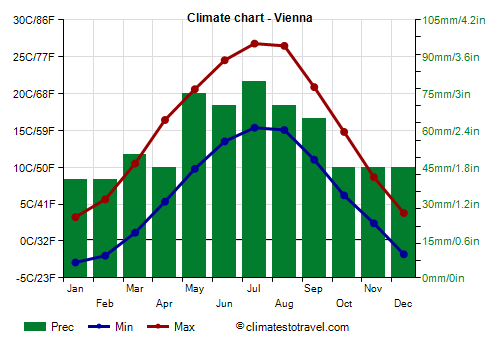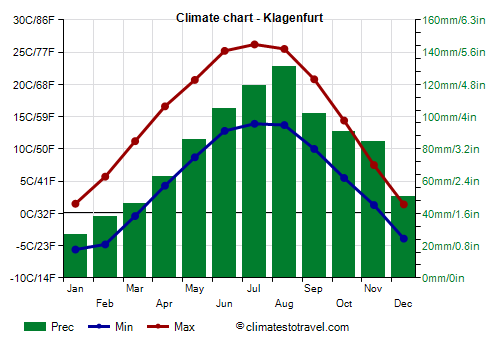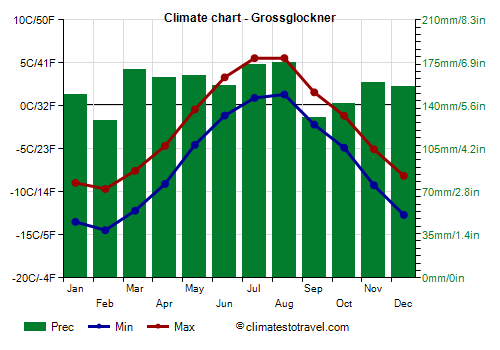Select units of measurement for the temperature and rainfall tables (metric or imperial).
Average weather, temperature, rainfall, sunshine
In Austria, a country crossed by the Eastern Alps, the climate is
moderately continental in the small plain area (see Vienna) and in the hill towns (see Salzburg, Graz, Linz, Innsbruck), while it is
alpine in the high mountains.
Precipitation (rain or snow) is abundant in the mountains, where it exceeds 1,000 millimeters (40 inches) per year almost everywhere, and often 1.500 mm (60 in), while it's lower in the Vienna area, where it drops to 675 mm (26.5 in). Winter is usually the driest season, while summer is the wettest season because of afternoon thunderstorms.
The climate in detail
Seasons
Winter in Austria is cold everywhere, even in the Danube valley, but especially in the valleys located at higher altitude, and even more so in the mountains. In Vienna, the Austrian capital, the average temperature in January is around freezing, but in the cities located at higher altitude and in the valleys among the mountains, the averages are even lower: for example in Klagenfurt, at 450 meters (1,500 feet) above sea level, the average temperature in January is -2.5 °C (27.5 °F).
Fog and low clouds are common in the valleys, and in particular in the Danube Valley: in winter, fog occurs on average from 4 to 11 days per month.
Snow is quite common everywhere, except in the area of Vienna, where it is rarer.
The lowest temperatures have been recorded after outbreaks of cold air masses from Russia: in these cases, the temperature can plunge to -20 °C (-4 °F) or even lower.
Summer in Austria is warm during the day, with generally cool nights. The maximum temperature is around 25/27 °C (77/81 °F) in Vienna and the other major cities. The morning is often sunny, while thunderstorms can break out in the afternoon, which are more frequent in the mountainous areas. However, even in summer sometimes the country can be affected by Atlantic fronts, which instead generally spare the Italian side (i.e. in the region of Alto Adige or South Tyrol).
Sometimes there may be hot and muggy days, especially in the plain (i.e. in the area of Vienna), with lows above 20 °C (68 °F) and highs above 30 °C (86 °F).
Heat waves of African origin are generally of short duration, but during these periods in the main cities the temperature can reach 36/38 °C (97/100 °F).
In the plain and at low altitude,
spring and autumn are usually cool.
In May and September, the temperature is usually pleasant (although sometimes it can get cold at night), and thunderstorms occur more rarely than in summer. On warmer days, the temperature can reach or slightly exceed 30 °C (86 °F).
April and October are very cool, sometimes cold: in these months sometimes it can freeze at night, and in April the northerly winds may bring some late snowfalls.
In autumn, in October, mists and fogs become quite frequent.
Spring and autumn in Austria are drier than summer; in autumn, the north side of the Alps is sheltered from the southerly winds that usually blow in this season, and bring heavy rains on the southern side, namely in Italy and Slovenia.
Plains and hills
Vienna

In the north-east, the area of
Vienna is the only one in which the altitude drops below 200 meters (650 feet). In winter, when the anticyclone dominates, cold air stagnates on the ground and the sky is gray. In summer, there may be hot and muggy periods.
That of Vienna is the least rainy area of the country. In particular, thunderstorms in summer are not as frequent and abundant as in Alpine and pre-Alpine areas.
In Vienna, the sun is rarely seen from November to January, while from April to September it shines about half the time (compared to the length of the days).

In the north-west, also
Linz, the capital of Upper Austria, is at a fairly low altitude (300 meters or 1,000 feet); here the temperatures are similar to those of Vienna, and barely lower in summer. However, the rainfall is more abundant, since it amounts to 830 mm (33 in) per year.
In the southeast, we find
Graz, the capital of Styria, 350 meters (1,150 feet) above sea level.
To the south-west of Linz, we find
Salzburg, at the foot of the Alps, at an altitude of 400 meters (1,300 feet).
Innsbruck is located in the west, in Tyrol, 580 meters (1,900 feet) above sea level.
Klagenfurt

In
Klagenfurt, the capital of Carinthia, in the south, at 450 meters (1,500 ft), the average temperature ranges from -2 °C (28.5 °F) in January to 20 °C (68 °F) in July.
In Klagenfurt, rainfall amounts to 945 mm (37 in) per year. As is usually the case in hilly areas near the mountains, summer is the rainiest season, due to thunderstorms in the afternoon.
Mountains
In
mountainous regions, winter is obviously very cold and snowy, but the sun shines more often than in the valleys because the mountains are above the layer of fog and low clouds that can form in periods of good weather. In summer, the climate becomes obviously cooler with increasing altitude. In addition, precipitation in the mountains is more abundant, both the winter snowfalls and the summer thunderstorms.
Some areas of Austria are subject to down-slope winds coming from the mountains: when the
Foehn blows from the south, the temperatures can suddenly increase, and snow can rapidly melt, causing floods and avalanches. In the south, in Carinthia, there's a variant of this wind called
Jauk.
Sankt Anton

In
Sankt Anton am Arlberg (Tyrol), located at 1,300 meters (4,265 feet) above sea level, the average temperature ranges from -4.2 °C (24.4 °F) in January to 15.3 °C (59.5 °F) in July.
In Sankt Anton, rainfall amounts to 1,275 mm (50 in) per year, and unlike in low-elevation areas, it is quite abundant even in winter. It usually snows from November to April, but it can occasionally snow in October and May as well.

Grossglockner

Above 3,000 meters (10,000 ft), on the
Grossglockner, which is the highest mountain in Austria with its 3,798 meters (12,461 ft), the average temperature is around freezing even in July and August. At the Sonnblick Observatory, located at 3,111 meters (10,207 ft) above sea level, the coldest record is -36.6 °C (-33.9 °F), set in February 1940, while the highest record is 15 °C (59 °F) and was set in July 1983.
On the Grossglockner, precipitation is abundant, 1,865 mm (73.5 in) per year, and almost always occurs in the form of snow.
When to go
The best times to visit
Vienna and the other major cities in Austria are late spring and early autumn, especially the months of
May, June, and September.
In mid-summer (July-August), thunderstorms are more intense, and it can be very hot at low altitudes. In cities located in hilly areas (see Salzburg, Innsbruck), it rains more than in Vienna, which in return can be hot and muggy. On the other hand, during this period, the temperatures in high mountains are more pleasant.
In September, forests begin to show the spectacular autumn colors.
Being cold and dull, and sometimes freezing and snowy, winter (December to February) is not the best period to visit cities.
For a
ski holiday, we can recall that in February the days are already longer than in December and January. In March and in early April, the days are even longer, and the weather is generally less cold.
On the highest mountains, there are resorts where you can go skiing even in summer.
What to pack
In
winter: bring warm clothes, such as a sweater or fleece, a down jacket, a hat, a scarf, gloves, an umbrella. For the mountains, mountain outfit, hiking boots.
In
summer: bring light clothes, a T-shirt and shorts, but also long pants, a jacket, and a sweatshirt; a raincoat or umbrella. For the mountains, hiking shoes, sunscreen and sunglasses; for the highest mountains and glaciers, warm clothes, such as a down jacket, a hat.
Climate data - Austria
| Graz (350 meters) |
|---|
|
| Jan | Feb | Mar | Apr | May | Jun | Jul | Aug | Sep | Oct | Nov | Dec |
|---|
| Min temp. | -5 | -4 | 0 | 4 | 9 | 13 | 15 | 14 | 10 | 5 | 1 | -4 |
|---|
| Max temp. | 3 | 7 | 12 | 17 | 21 | 25 | 27 | 26 | 21 | 16 | 9 | 4 |
|---|
| Precip. | 20 | 30 | 35 | 50 | 95 | 120 | 120 | 130 | 90 | 65 | 50 | 40 |
|---|
| Prec. days | 4 | 4 | 6 | 8 | 11 | 12 | 10 | 10 | 9 | 7 | 7 | 5 |
|---|
| Humidity | 86% | 77% | 69% | 65% | 67% | 69% | 68% | 72% | 77% | 82% | 87% | 89% |
|---|
| Day length | 9 | 10 | 12 | 14 | 15 | 16 | 15 | 14 | 12 | 11 | 9 | 9 |
|---|
| Sun hours | 3 | 4 | 5 | 6 | 7 | 7 | 8 | 7 | 6 | 5 | 3 | 3 |
|---|
|
| Grossglockner (3,110 meters) |
|---|
|
| Jan | Feb | Mar | Apr | May | Jun | Jul | Aug | Sep | Oct | Nov | Dec |
|---|
| Min temp. | -13 | -14 | -12 | -9 | -5 | -1 | 1 | 1 | -2 | -5 | -9 | -13 |
|---|
| Max temp. | -9 | -10 | -8 | -5 | 0 | 3 | 6 | 6 | 2 | -1 | -5 | -8 |
|---|
| Precip. | 150 | 130 | 170 | 165 | 165 | 155 | 175 | 175 | 130 | 140 | 160 | 155 |
|---|
| Prec. days | 15 | 15 | 17 | 17 | 18 | 18 | 18 | 17 | 14 | 13 | 15 | 17 |
|---|
|
|
| Sun hours | 4 | 5 | 5 | 5 | 5 | 5 | 5 | 5 | 5 | 5 | 4 | 4 |
|---|
|
| Innsbruck (580 meters) |
|---|
|
| Jan | Feb | Mar | Apr | May | Jun | Jul | Aug | Sep | Oct | Nov | Dec |
|---|
| Min temp. | -5 | -4 | 0 | 4 | 8 | 12 | 13 | 13 | 9 | 5 | 0 | -4 |
|---|
| Max temp. | 4 | 7 | 12 | 16 | 21 | 24 | 25 | 25 | 20 | 16 | 9 | 4 |
|---|
| Precip. | 45 | 35 | 60 | 60 | 90 | 125 | 135 | 145 | 90 | 70 | 60 | 50 |
|---|
| Prec. days | 8 | 7 | 9 | 9 | 11 | 14 | 14 | 13 | 10 | 8 | 9 | 8 |
|---|
| Humidity | 82% | 75% | 68% | 64% | 65% | 68% | 70% | 72% | 75% | 77% | 82% | 85% |
|---|
| Day length | 9 | 10 | 12 | 14 | 15 | 16 | 16 | 14 | 12 | 11 | 9 | 8 |
|---|
| Sun hours | 3 | 4 | 5 | 6 | 7 | 7 | 7 | 7 | 6 | 5 | 3 | 3 |
|---|
|
| Kitzbuhel (750 meters) |
|---|
|
| Jan | Feb | Mar | Apr | May | Jun | Jul | Aug | Sep | Oct | Nov | Dec |
|---|
| Min temp. | -7 | -6 | -2 | 2 | 6 | 10 | 12 | 11 | 8 | 4 | -2 | -6 |
|---|
| Max temp. | 1 | 4 | 9 | 14 | 19 | 22 | 24 | 23 | 19 | 15 | 7 | 2 |
|---|
| Precip. | 70 | 65 | 85 | 80 | 110 | 155 | 170 | 150 | 105 | 75 | 80 | 85 |
|---|
| Prec. days | 10 | 9 | 12 | 12 | 13 | 16 | 15 | 14 | 11 | 9 | 11 | 11 |
|---|
|
|
| Sun hours | 4 | 4 | 5 | 5 | 6 | 6 | 7 | 7 | 6 | 6 | 4 | 3 |
|---|
|
| Klagenfurt (450 meters) |
|---|
|
| Jan | Feb | Mar | Apr | May | Jun | Jul | Aug | Sep | Oct | Nov | Dec |
|---|
| Min temp. | -6 | -5 | 0 | 4 | 9 | 13 | 14 | 14 | 10 | 6 | 1 | -4 |
|---|
| Max temp. | 2 | 6 | 11 | 17 | 21 | 25 | 26 | 26 | 21 | 14 | 8 | 1 |
|---|
| Precip. | 25 | 40 | 45 | 65 | 85 | 105 | 120 | 130 | 100 | 90 | 85 | 50 |
|---|
| Prec. days | 4 | 5 | 6 | 8 | 10 | 10 | 11 | 11 | 8 | 8 | 8 | 6 |
|---|
| Humidity | 86% | 79% | 70% | 66% | 66% | 67% | 68% | 71% | 77% | 83% | 87% | 90% |
|---|
| Day length | 9 | 10 | 12 | 14 | 15 | 16 | 15 | 14 | 12 | 11 | 9 | 9 |
|---|
| Sun hours | 3 | 5 | 6 | 7 | 7 | 8 | 8 | 8 | 6 | 4 | 2 | 2 |
|---|
|
| Linz (265 meters) |
|---|
|
| Jan | Feb | Mar | Apr | May | Jun | Jul | Aug | Sep | Oct | Nov | Dec |
|---|
| Min temp. | -3 | -3 | 1 | 5 | 9 | 13 | 14 | 14 | 10 | 6 | 2 | -2 |
|---|
| Max temp. | 2 | 5 | 10 | 16 | 20 | 24 | 26 | 25 | 20 | 14 | 7 | 3 |
|---|
| Precip. | 60 | 50 | 65 | 65 | 70 | 90 | 105 | 85 | 65 | 50 | 60 | 65 |
|---|
| Prec. days | 11 | 10 | 11 | 11 | 10 | 12 | 12 | 10 | 9 | 8 | 10 | 12 |
|---|
| Humidity | 88% | 83% | 75% | 68% | 70% | 71% | 70% | 71% | 78% | 84% | 88% | 89% |
|---|
| Day length | 9 | 10 | 12 | 14 | 15 | 16 | 16 | 14 | 12 | 11 | 9 | 8 |
|---|
| Sun hours | 2 | 3 | 4 | 6 | 8 | 7 | 8 | 8 | 6 | 4 | 2 | 1 |
|---|
|
| Salzburg (425 meters) |
|---|
|
| Jan | Feb | Mar | Apr | May | Jun | Jul | Aug | Sep | Oct | Nov | Dec |
|---|
| Min temp. | -4 | -3 | 1 | 4 | 9 | 12 | 14 | 14 | 10 | 6 | 1 | -2 |
|---|
| Max temp. | 4 | 6 | 10 | 15 | 20 | 23 | 25 | 25 | 20 | 15 | 9 | 4 |
|---|
| Precip. | 70 | 50 | 85 | 75 | 135 | 155 | 145 | 155 | 115 | 80 | 70 | 70 |
|---|
| Prec. days | 11 | 10 | 12 | 10 | 14 | 15 | 15 | 13 | 11 | 10 | 10 | 12 |
|---|
| Humidity | 81% | 76% | 71% | 65% | 68% | 69% | 69% | 71% | 76% | 78% | 82% | 82% |
|---|
| Day length | 9 | 10 | 12 | 14 | 15 | 16 | 16 | 14 | 12 | 11 | 9 | 8 |
|---|
| Sun hours | 2 | 3 | 4 | 5 | 6 | 6 | 7 | 7 | 6 | 4 | 3 | 2 |
|---|
|
| St Anton (1,300 meters) |
|---|
|
| Jan | Feb | Mar | Apr | May | Jun | Jul | Aug | Sep | Oct | Nov | Dec |
|---|
| Min temp. | -8 | -7 | -3 | 0 | 4 | 8 | 10 | 9 | 6 | 2 | -3 | -6 |
|---|
| Max temp. | -1 | 3 | 8 | 11 | 17 | 19 | 21 | 21 | 17 | 12 | 4 | 0 |
|---|
| Precip. | 105 | 95 | 90 | 65 | 85 | 135 | 160 | 160 | 95 | 75 | 100 | 105 |
|---|
| Prec. days | 11 | 9 | 12 | 11 | 13 | 16 | 16 | 15 | 12 | 9 | 11 | 12 |
|---|
|
|
|
|
| Vienna (180 meters) |
|---|
|
| Jan | Feb | Mar | Apr | May | Jun | Jul | Aug | Sep | Oct | Nov | Dec |
|---|
| Min temp. | -3 | -2 | 1 | 5 | 10 | 14 | 15 | 15 | 11 | 6 | 2 | -2 |
|---|
| Max temp. | 3 | 6 | 11 | 16 | 21 | 25 | 27 | 26 | 21 | 15 | 9 | 4 |
|---|
| Precip. | 40 | 40 | 50 | 45 | 75 | 70 | 80 | 70 | 65 | 45 | 45 | 45 |
|---|
| Prec. days | 9 | 7 | 9 | 7 | 9 | 8 | 9 | 8 | 7 | 7 | 8 | 9 |
|---|
| Humidity | 80% | 75% | 68% | 63% | 66% | 66% | 63% | 65% | 71% | 79% | 82% | 83% |
|---|
| Day length | 9 | 10 | 12 | 14 | 15 | 16 | 16 | 14 | 12 | 11 | 9 | 8 |
|---|
| Sun hours | 2 | 4 | 5 | 7 | 8 | 8 | 8 | 8 | 6 | 4 | 2 | 2 |
|---|
|
See also the
temperatures month by month